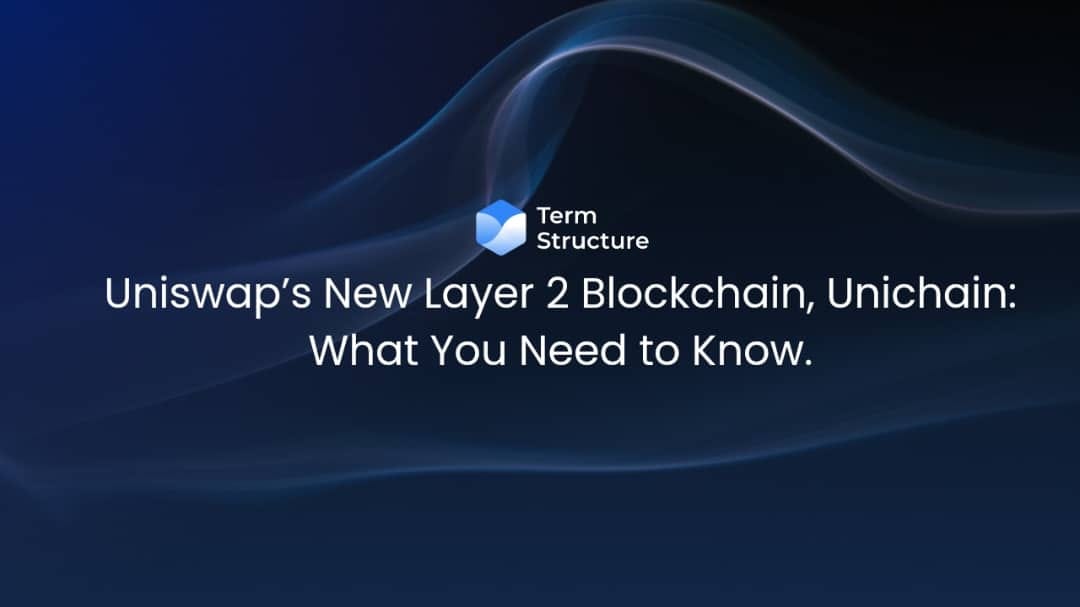Uniswap’s New Layer 2 Blockchain, Unichain: What You Need to Know.

Uniswap, a leading DEX in the DeFi universe has always set the bar high for other players in the market consistently. In its latest development of L2 blockchain, Unichain, it has predicted the future of decentralized finance (DeFi) for users and developers to interact with digital assets across multiple blockchains. By integrating Optimism’s OP Stack and improved by technical capabilities of Uniswap, Unichain is going to solve the problems of fragmented liquidity, high TPS and low fees in DeFi and introduce a number of innovations making DeFi more efficient and friendly.
What is Unichain?
Unichain is Uniswap’s Layer 2 solution that aims to provide liquid, quicker, cheaper, and more efficient trading at scale while solving some of the biggest pain points in DeFi including trading fragmentation and high gas costs. Its development is based on the OP Stack of Optimism, Unichain interacts with other L2s in Optimism’s ecosystem, providing easy cross chain liquidity access and mitigating the challenges that are accompanied by trading across multiple chains.
The imperative for expansion is rooted in the desire of Uniswap to continue to adapt to the expanding DeFi sector while simultaneously addressing questions pertaining to interoperability, efficiency, and simplicity for its user base and developers.
Why Unichain? Layer 2 in Wireless Mesh Networks.
The Ethereum mainnet is not only the biggest and the most popular smart contract platform but also faces serious issues with scalability, which causes network congestion, high gasoline prices, and slow processing of transactions. Thus the need for solutions that could accommodate the increasing volume of transactions of decentralized finance protocols.
L2 solutions emerged to solve these scalability issues by enabling transactions to occur off-chain within the Ethereum architecture yet share the same level of security decentralization as Layer 1.
Arbitrum and Optimism are just two of the Layer 2 protocols that Uniswap has already connected with. But there is Unichain, which is Uniswap’s L2 blockchain aimed at implementing cross chain liquidities and having nearly instant transactions.
Key Features of Unichain.
A. Lightning Fast Transactions
Unichain provides speeds of transactions that are considerably faster. Taking block times as low as 200250 milliseconds, Unichain is set to offer the users almost real time experience. This is quite a marked improvement over average block time on Ethereum, which currently stands at roughly 1315 seconds.
This kind of speed is vital especially where there is constant interaction such as the high frequency trading in decentralized applications (dApps). With these faster transactions, Unichain looks to attract more users and developers into its ecosystem making its liquidity pools, and overall usage, increase.
B. Lower Transaction Costs
The use of Layer 2 solutions has one major plus on the side of transactions: those are the decreased transaction costs. The transactions on each side of the Unichain network will be possible at a cost between 1/5th to 1/100th the cost of Layer 1 Ethereum. These lower fees enable more users to engage with DeFi platforms and applications, something important to smaller traders, who would otherwise be sidelined by high gas prices.
The cost efficiency of Unichain also enables developers to create dApps and further develop decentralized applications, all in an effort that does not include the constant headache of wondering if the high fees are reasonable for their users.
C. Cross Chain Compatibility
Another critical problem of DeFi is concentration of liquidity– when tokens are distributed across several chains posing a challenge for a user looking to get large amounts of funds. Unichain solves this by enabling non-bridged cross chain swaps especially with other L2 on the Optimism Superchain. This will mean that the assets available throughout the network can be easily migrated in and out of Unichain as well as other L2s to gain optimal liquidity.
In addition, Uniswap Labs plans to enhance connectivity on other blockchains outside the Optimism Superchain. This focus on cross chain transactions eliminates bridging solutions and fragmented liquidity pool problems thus making DeFi trading integrated and easier.
Decentralization & Security: New Innovations
The solutions Unichain offers to its customers are based primarily on security and decentralization. Uniswap Labs has partnered with leading developers and organizations like Flashbots to introduce two key innovations.
Community Validator Network:
As a way to even more decentralize Unichain, Uniswap Labs will launch a validator network built on the community. The validators will be needed to contribute to the securing of the network and must maintain decentralization of the network, and the capability of the network from censorship.
Trusted Execution Environment (TEE):
This makes the block production process in Unichain safe and it is backed by verification. In a decentralized environment, TEE makes it possible to have more transparency and trust than in the network.
All these improvements are a part of Uniswap promoting the decentralized ethos and continued faith in the space much as a new form of technology emerges.
Developer Centric Tools And Environment
Uniswap Labs aims to create a strong supporting system for decentralized applications and DeFi builders to develop and deploy a new generation of consumer applications on Unichain.
It is important to note that Unichain is an open source platform and anybody can contribute to its development. This open approach influences development, innovation and collaboration among blockchain communities. There, developers will have an opportunity to study samples of smart contracts, guidelines on creating liquidity pools, to mention a few; API support to fetch data as well.
Further, applications such as the Zerion Wallet have already included preliminary support for the Unichain Token allowing developers and users to assess the token based on the familiar interface for handling tokens and observing transactions.
The Zerion API also enables developers to retrieve onchain data which includes price of token, history of trading, and DeFi holdings.
The higher the adoption rate of Unichain increases, we will see more resultant wallets, applications, and tools being added to its structure for newcomers and innovative developers to participate in one network ecosystem.
The Future of Unichain: Mainnet and Beyond
Unichain is still in the public testnet phase of its development where developers and potential users can experiment with the network and the situations in which transactions are processed and make suggestions. The timeline of launching the mainnet should be by November 2024. After launch, Unichain will be essential to Uniswap’s multichain approach and become the basis for further DeFi developments.
In 2025, Uniswap aims to add other decentralization features as a validation network that will let community members fund the blockchain. The synergy of a high performance L2 solution with community driven option for security and governance might place Unichain in one of the most decentralized secure blockchains in the market.
Why Unichain Matters for DeFi
Unichain becomes a meaningful addition not only to Uniswap’s platform but for DeFi industry as a whole. Here are a few reasons why Unichain is set to have a lasting impact:
A. Scaling Ethereum
One of Ethereum’s greatest drawbacks is the lack of scalability that has been affecting the ecosystem for a long time. Some of such problems Unichain has been able to solve by providing a faster, cheaper, and more efficient Layer 2 solution hence enhancing scalability of Ethereum without the need to compromise security and decentralization.
B. Access to Liquidity
This means that Unichain’s approach to solve the cross chain liquidation problem will likely positively impact the fragmentation of liquidity into various Layer 2 solutions. Unichain can make such trades easier, larger, and less prone to slippage, as well as bring increased certainty of liquidity for DeFi consumers.
C. Lowering Barriers to Entry
Thanks to the cheaper fees and faster transaction time Unichain makes DeFi more inclusive to little traders and developers. This could lead to explosive growth in usage of DeFi related applications, especially in areas where high transaction costs have been a prohibitive factor.
D. Decentralization Innovation
These are new decentralization mechanisms that promise to make a new generation of decentralized finance based on the example of Unichain. The prerequisites of high security, openness, and Public participation define new standards for new block chain networks.
Challenges On The Road To Adoption
Centralization Concerns:
Critics argue that the proposed community validation network may lead to increased centralization, as staking UNI could give more control to those with larger stakes, potentially sidelining smaller participants.
Security Risks:
While Unichain employs Trusted Execution Environments (TEEs) for security, reliance on specific technologies could pose risks if vulnerabilities are discovered in those systems.
Market Fragmentation:
Despite aiming to reduce fragmentation in Layer 2 solutions, there are concerns that introducing another Layer 2 could complicate the landscape further rather than streamline it.
Adoption Challenges:
Integrating a new blockchain into existing financial systems may be difficult, especially for traditional institutions that prefer established processes over radical innovations.
Speculative Nature:
The initial hype surrounding Unichain may not translate into long-term success; skepticism remains about whether it can deliver on its promises or if it will merely become another layer in an already crowded market
Conclusion
Unichain is more than just the newest Layer 2 solution, it is Uniswap’s platform of choice and pledge to engage with and solve some of the biggest issues in DeFi. Starting with near instant transactions and low fees, further through cross-chain liquidity, up to a developer-friendly environment, Unichain will shake up the DeFi universe.
As transition to mainnet moves, innovations that are still visible during the development on the testnet, should bring even more new and interesting things that will make Unichain more interesting and attractive for its users and developers. From cheaper, faster transactions for traders to the development platforms for builders behind the next big dApp, Unichain provides the opportunities you need.
For more detailed information and to stay updated on Unichain’s development, visit Unichain’s official website.

